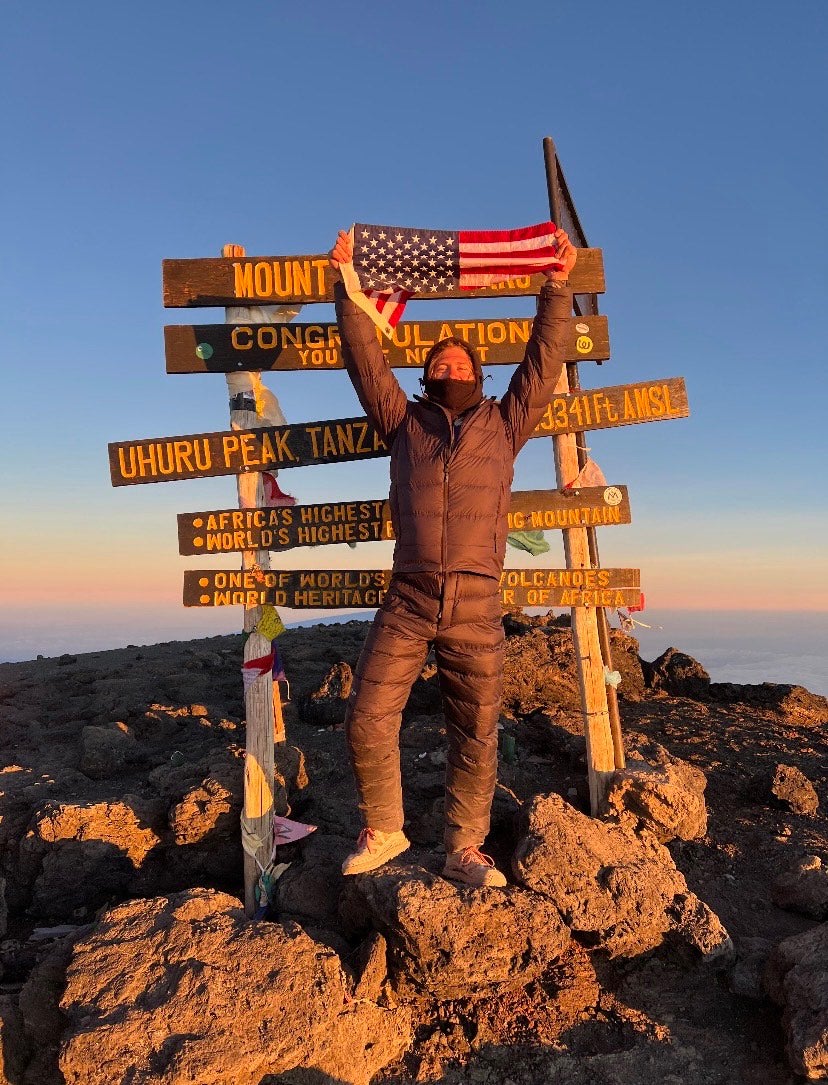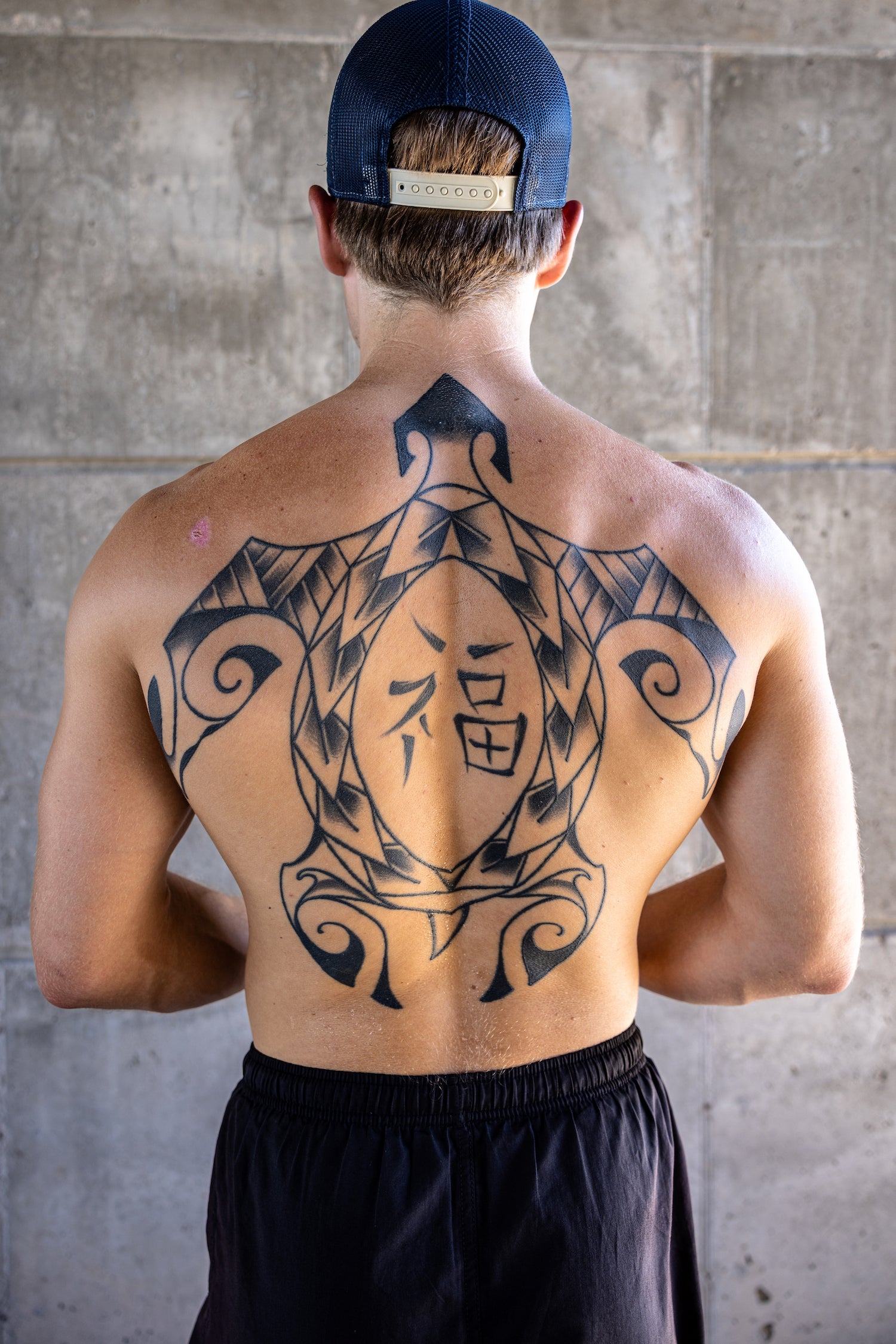Editor's note: This story is being published in conjunction with National Suicide Prevention Week, Sept. 4–10.
When David Hamrick reached the summit of Mount Kilimanjaro after five days of climbing, he cried. But he didn’t know if they were tears of joy or sorrow.
“They were somewhere in the middle,” says Hamrick, a Navy veteran and a fourth-year student at Arizona State University. “I was happy that I finished but sad that Alec wasn’t with me to share in the joy.”
Hamrick is referring to Alec Serna, a childhood friend and fellow naval service member who died on May 19, 2018. Hamrick uses a daily exercise regimen to help him process his grief, which includes running, hiking, bodybuilding, and rock climbing.
David Hamrick at the summit of Mount Kilimanjaro. Photo courtesy David Hamrick
The 19,341-foot climb up Mount Kilimanjaro, a dormant volcano in Tanzania, took place in July. Hamrick used the challenge to honor his fallen friend while grieving for him at the same time.
Serna died by suicide. His sudden death took everyone by surprise.
“Alec was 6-foot-5, tall, dark and handsome and he had a presence that no one could ignore when he walked into a room,” says Hamrick, a sports science and performance programming major in the College of Health Solutions. “He had a great smile, his energy was always positive and he just lifted everyone up.”
Hamrick said Serna first lifted him up after high school ended. At the time, Hamrick was an audio engineer and living out of his car in west Hollywood near the Sunset Strip. He joined a gym for $10 a month, which enabled him to take daily showers and change his clothes. Beyond that, he had no master plan. But Serna soon changed his mind.
“(Alec) was a rescue swimmer from the Navy and jumped out of helicopters, shooting machine guns. I thought that was pretty cool,” Hamrick says. “Things soon went south in Hollywood and so that was my inspiration for joining the Navy.”
Hamrick enlisted in 2016 and got an assignment on the USS Anchorage out of San Diego, doing maintenance and preservation work on the ship.
“The Navy really pushed me to my full mental and physical limits, and I would have never known what those limits were prior to the Navy,” Hamrick says. “Prior to my service, I was sitting in a recording studio for 18 to 20 hours a day, living a somewhat easy life with no outside stressors.”
Meanwhile, Serna's life had its own stressors. A long-term personal relationship ended, and it sent him into a downward spiral.
“Alec messaged me one day that he wasn’t doing so well, so I went to visit him at his apartment almost every day,” Hamrick says. “One day he had a gun to his head and a bottle of alcohol between his legs. Once I realized how serious the situation was, I’d try and spend as much time with him as I could. I made sure he fell asleep before me every single day because he wasn’t getting much sleep.”
Hamrick said he did everything he could to help Serna with his depression. He accompanied him on daily beach runs, outings at the gym, meals, and they even attended a reggae concert together. Nothing seemed to help.
“(After the concert) was the first night I fell asleep before him, and that was the night he took his life,” Hamrick said. “I originally put a lot of blame on myself regarding the whole situation. It was an extremely hard time because this came totally out of the blue.”
David Hamrick (left) and Alec Serna in happier times. Photo courtesy David Hamrick
Rebecca K. Blais, a clinical psychologist and an associate professor of psychology at ASU, says the circumstances around Serna's death is something she’s seeing more of with active-duty service members. Blais, whose research includes military sexual violence and suicide, said broken relationships can trigger a response in people who serve.
“Service members who enter the military are, by and large, expecting to fight in combat. The youngest of our service members have only known war given the duration of conflicts following 9/11,” Blais said. “Now that the war is over, many of them don’t know what to do. … When you combine a lack of purpose and failing personal relationships, you will see an uptick in suicide risk.”
READ MORE: Supporting our military's mental health
Hamrick spent the next eight months grieving on the ship, looking out on the ocean for answers. His shipmate, Kevin Murphy, immediately sensed his despair.
“Alec and David were childhood buddies, the best of friends, and (Alec) was a larger-than-life character with a gregarious personality,” says Murphy, who still serves in the Navy. “When Alec died, it was very hard on David. He was completely distraught. It was pretty bad. I did my best to talk to him to help him grieve, but when you’re at sea for months at a time, you don’t really get a lot of time to yourself.”
Hamrick said though the ship didn’t offer physical or emotional space to grieve, he made a vow that once it docked, he was going to “start running.”
And he did.
Less than a month after Hamrick’s ship docked, he participated in the Hot Chocolate 15k race in San Diego. He took second place and got addicted to running.
“When I ran, it was the only time I wasn’t thinking about life and the stressors that come with it,” Hamrick says. “All I had to do was put one foot in front of the other and just breathe. It was very simple.”
David Hamrick's tribute tattoo to Alec Serna. Photo by Charlie Leight/ASU News
Pretty soon he added hiking and backpacking to his fitness regimen. He has hiked various sites in Arizona, including South Mountain, Camelback Mountain, Piestewa Peak, the Flatiron, McDowell Mountains, Picacho Peak, Humphreys Peak and Thumb Butte. He also competes in regional Spartan Races throughout the country.
“I was diagnosed with depression and anxiety disorder upon discharging from the Navy,” Hamrick says. “I have peace in the outdoors.
“This journey has allowed me to gain some understanding about the mental health stigma and how it should be broken,” he says. “This has given me a purpose, a passion and something meaningful to my life.”
Recently, Hamrick got a large tattoo in tribute to Serna. It isn’t small or insignificant, covering his entire back. Even though some say it might be too big, Serna’s brother, Logan Moores, thinks it’s fitting.
“For a long time, Alec carried David on his back,” Moores said. “And now David is carrying Alec on his back.”
Suicide prevention tips
Provided by Associate Professor Rebecca K. Blais
• If you have a concern about someone, reach out and tell that person that you care about them. Also encourage them to get professional help.
• Know where to get help so that you can help yourself or someone you care about. If you are experiencing thoughts of suicide, you can call 988 or 1-800-273-TALK.
• Find meaning and purpose in your life and find ways to live that every single day.
• If you are supporting someone as they experience suicidal ideation, be sure to take care of yourself and seek social support or professional help.
• Reduce risk for death by suicide by removing easy access to firearms or other lethal means. Reducing use of substances that impair decision-making or increase impulsivity, such as alcohol, is also important.
Top photo: David Hamrick, a fourth-year sports science and performance programming student and a Navy veteran, poses on the Pima Canyon trail on South Mountain on Aug. 26. Photo by Charlie Leight/ASU News
More Health and medicine

Dynamic data duo advances health research
The latest health research promises futuristic treatments, from cancer vaccines to bioengineered organs for transplants to medical nanobots. While these technologies may one day be…

New study reveals high levels of toxins in seized cannabis from Arizona and California
A recent study conducted by researchers from Arizona State University has uncovered alarming levels of Fusarium mycotoxins in illicit cannabis samples seized in Arizona and California.The study found…

PhD student builds bridges with construction industry to prevent heat-related illnesses
It is no secret that Arizona State University has innovative researchers working to help solve everyday problems.According to a new preliminary report issued by Maricopa County, there were more…





